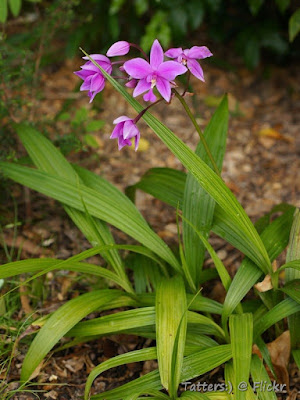Spathoglottis paulinae is found in Papua New Guinea, West New Guinea in tropical north Queensland between Cooktown and Ingham and in northern parts of the Northern Territory. It grows in open forests in wet situations, growing among grass at elevations of 300-800 meters above sea level. It is frequently found in soaks and moist depressions, often in heavy clay soils.
Spathoglottis paulinae also called as The Small Purple Orchid, Pauline Richmond's Spathoglottis, Bletia paulinae, Spathoglottis rivularis, Spathoglottis soutteriana, is a species of the genus Spathoglottis. This species was described by Ferdinand von Mueller in 1867.
IDENTIFY SPATHOGLOTTIS PAULINAE ORCHID PLANT
Spathoglottis paulinae is found in Papua New Guinea, West New Guinea in tropical north Queensland between Cooktown and Ingham and in northern parts of the Northern Territory. It grows in open forests in wet situations, growing among grass at elevations of 300-800 meters above sea level. It is frequently found in soaks and moist depressions, often in heavy clay soils.
The Small Purple Orchid is a medium to large sized, hot to warm growing terrestrial species with a short rhizome that giving rise to a minute, 3-5 cm long pseudobulb carrying 2 to 4, erect-patent, narrowly linear, long acuminate, glabrous, narrowing below into the petiolate base, 8–18 cm long and 3–5 cm wide leaves.
Pauline Richmond's Spathoglottis blooms in the spring (between July and March) on a 110 cm long, basal, erect, racemose inflorescence which extends during blooming and has successive 6 to 8 open at a time, opening flowers. The flowers are pale pink to magenta, rarely white, center of lip (callus, claw and base of mid-lobe) yellow, tip of mid-lobe darker than the petals. Peduncle and rachis pinkish brown. Floral bracts same colour as sepals, sometimes with greenish tips.
SPATHOGLOTTIS PAULINAE ORCHID PLANT CARE AND CULTURE
Cultural information should only be used as a guide, and should be to be adapted to suit you. Your physical location; where you grow your plants, how much time you have to devote to their care, and many other factors, will need to be taken into account. Only then can you decide on the cultural methods that best suit you and your plants.
Light:
Spathoglottis paulinae like indirect sunlight. 20000 - 50000 lux or speckled sunlight protected from the hottest direct sunlight of the day, 7500 lux for the youngest plants. If the plants don’t bloom, the amount of direct sunlight the plants are receiving has to increase.
Temperature:
The Small Purple Orchid are generally warm growing plants liking temperatures up to the high 30˚ C and they can tolerate temperatures down into the upper 15˚ C. If the temperature in growing areas fall below 15° C for extended period, the plant may revert back to growth stage and flowering may be delayed.
Humidity:
Pauline Richmond's Spathoglottis prefer high level of humidity for better growth. Humidify the air around the plant is necessary for flowering. Misting plants daily is also effective .Grower can place a humidifier near the orchids to maintain the humidity. A pebble tray filled with water and placed underneath orchid pots also keeps air moist.
Substrate, growing media and repotting:
Spathoglottis paulinae are very forgiving as to the potting media. You can use a media based on 75% high quality soilless mix used for hanging baskets and larger containers mixed with 25% our orchid potting media which incorporates expanded slate. Outdoor landscaping media can incorporate more orchid media for drainage - bark, perlite, sphagnum moss, and various other components. The mix is very free draining but holds more moisture than regular media for epiphytic orchids.
Repotting isn’t necessary, but potted plants should be repotted in a rich organic potting mixture once the soil has become depleted. Their root systems are fairly extensive for their size. Make sure not to damage them.
Watering:
The Small Purple Orchid require good drainage in the media, so after a thorough watering allow the media to dry on top but you do not want the container to dry out altogether. Do not allow to sit in water. Water thoroughly in the morning once to twice weekly depending on your cultural conditions (light, temperature, humidity, air movement, etc.) allowing the top of the media to dry slightly between waterings. If the potting media is top-dressed with expanded slate, the area next to the pseudobulbs will dry out nice and quickly.
Fertilizer:
Spathoglottis paulinae like fairly high feedings of fertilizer with every watering. In outdoors, use of any slow release fertilizer containing equal parts nitrogen, phosphorus and potassium and micronutrients in the 4 - 6 months release formulations gives better growth. Fertilization with diluted fertilizer (1/4 strength) every two to three weeks interval is also effective. Fertilizers with trace elements of iron and magnesium should not be used as a chemical imbalance may occur that can be harmful to the plants.















COMMENTS